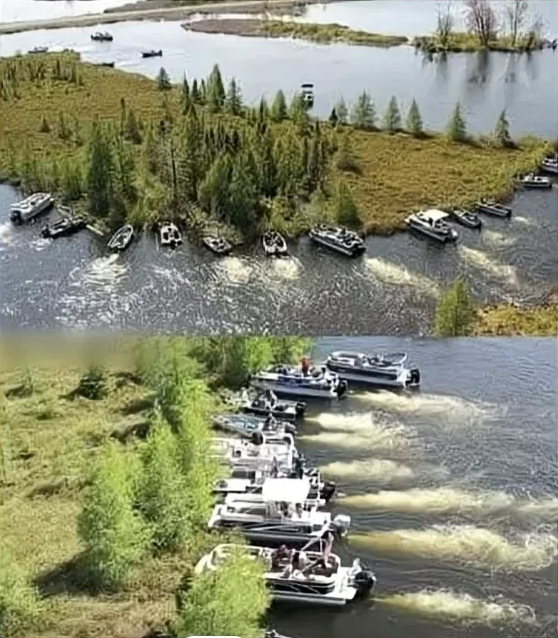
Every year in Wisconsin, dozens of boat owners band together for one of the most unusual community efforts you’ll ever see: moving a 40-acre floating island on Lake Chippewa.
The bog—made of peat, roots, and mature trees—isn’t firmly anchored to the lake bottom. It floats. And when winds catch the trees like sails, the entire island drifts across the water like nature’s largest, slowest boat.
The problem comes when it blocks the bridge connecting the lake’s east and west sides. When the island parks itself in front of critical infrastructure, the community has to push it back.
So they do. With their boats.
The photo shows the operation in progress—dozens of boats lined up against one edge of the island, engines churning water as they collectively push against forty acres of floating land. The island itself is visible in the background, covered in grass and mature trees, looking like it belongs on solid ground except for the fact that it’s clearly drifting in the middle of a lake.
Because the island is legally protected and can’t be broken apart, moving it requires favorable winds and often multiple attempts. You can’t just bulldoze a protected ecosystem, even when it’s blocking your bridge. You have to wait for the right conditions, gather enough boats, and push together.
This is community problem-solving at its most literal. Not a metaphorical “we all need to push in the same direction,” but actual physical pushing of a shared obstacle that affects everyone.
The image of dozens of boats working together against this massive floating island is almost comically Midwestern. Of course Wisconsin residents handle their drifting island problem by gathering their boats and just… pushing it. No dramatic engineering solution, no government intervention, just: the island’s in the way, let’s move it.
But there’s something beautiful in that simplicity. The problem is clear. The solution is obvious. So people show up with their boats and do what needs to be done.
Moving a 40-acre floating island isn’t quick. It’s not easy. Those boats are pushing against massive weight—peat, roots, mature trees, all soaked with water, creating an island that probably weighs thousands of tons. One boat would accomplish nothing. Ten boats might make it budge slightly. But dozens of boats, all pushing together, can actually move it.
That’s a perfect metaphor for community action. Individual effort often feels futile against massive problems. But collective effort—everyone showing up with whatever resources they have (in this case, boats) and pushing together—can move islands.
“Because the island is legally protected and can’t be broken apart, moving it requires favorable winds and often multiple attempts.”
This constraint makes the effort even more interesting. They can’t take the easy way out, can’t just break up the island into manageable pieces. They have to respect the ecosystem, work with its integrity intact, wait for conditions that make success possible.
Some years, they probably try and fail. The winds aren’t right, they don’t have enough boats, the island is too firmly settled. So they try again. And again. Until eventually, the conditions align and the collective push succeeds.
That’s perseverance. That’s community commitment. That’s the understanding that some problems don’t have instant solutions—they require repeated effort, patience, and the willingness to show up again even when previous attempts failed.
The lake residents could probably lobby to have the island removed, to eliminate this recurring problem permanently. But they don’t. They accept it as part of living on Lake Chippewa, one of those quirks that makes their home unique. Every year, when the island blocks the bridge, they gather their boats and push it back.
There’s something deeply human in this annual ritual. It’s not a crisis—it’s a predictable challenge that requires community response. Everyone knows it’s coming. Everyone knows what needs to be done. So when the time comes, they show up.
The photo captures that moment—dozens of boats creating wakes against the island’s edge, working together to push forty acres of floating land back where it belongs. The trees on the island sway slightly from the movement, evidence that all this effort is actually working.
In an era when community feels increasingly fractured, when collective action seems impossibly difficult, there’s something reassuring about this story. Here’s a community that literally bands together to push an island. They don’t argue about whose responsibility it is. They don’t wait for someone else to solve it. They just show up with their boats and push.
And eventually, the island moves. Because that’s what happens when enough people push together in the same direction.
The floating island of Lake Chippewa will drift again next year. And the boat owners will gather again. And they’ll push it back again. Because that’s what communities do—they show up for the challenges they know are coming, they bring what resources they have, and they push together until the problem moves.